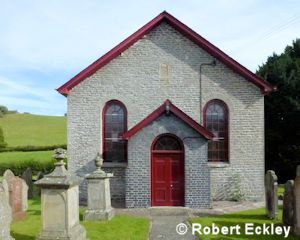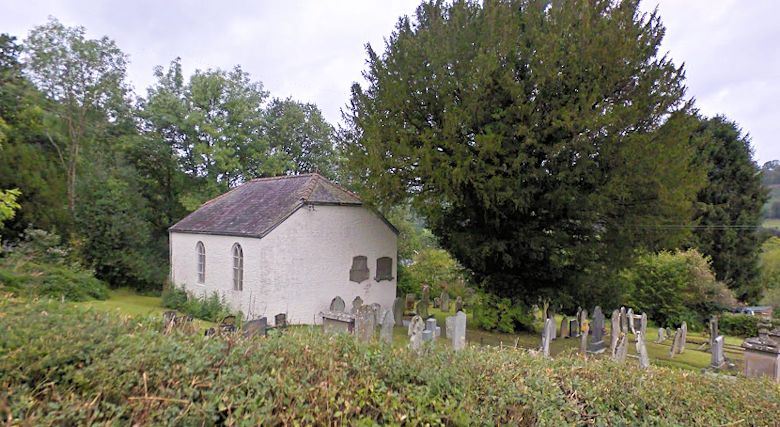Parish Pages - Crickadarn / Crucadarn

[Photography by Google StreetView, September 2011]
The parish of Crickadarn extends about five miles westwards from the river Wye, which forms its eastern border. The Wye is also the county border between Breconshire (on its west bank) and Radnorshire (on its east bank). The northern border of the parish follows the course of Cletwr Brook, while its southern border follows the course of Sgithwen Brook. Both brooks are tributaries of the Wye. Crickadarn parish shares borders with the Breconshire parishes of Gwenddwr (in the north), Merthyr Cynog (in the west), a detached part of Gwenddwr (in the southwest) and Llandefalle (in the southeast). Across the Wye, in Radnorshire, are the parishes of Llandeilo graban (in the northeast) and Llanstefan (in the east).

The largest community in Crickadarn is Erwood which developed around the confluence of the Wye and Clettwr Brook. The parish church, dedicated to St Mary, is situated in the tiny village of Crickadarn where Horeb Independent Chapel (right) is also situated.
Trivia: In 1981, the John Landis horror-comedy An American Werewolf in London featured the fictional Yorkshire village of East Proctor. In reality, the village scenes were shot on location in Crickadarn, where a then-derelict cottage became The Slaughtered Lamb public house. For further details, see the Worldwide Guide to Movie Locations website.
In 1809, in his A History of the County of Brecknock, Theophilus Jones wrote:
CRICKADARN, or CERRIG-CADARN:So called from the solidarity and firm texture of the rocks and stones which appear frequently on the surface in different parts of this parish. The Church is in latitude 52 8, longitude 3 15, upon a high bank almost overhanging the rive Clettwr, which running over rocks and confined by natural walls, nearly perpendicular, falls into the Wye at Errwd. This Cefn, or high ridge, is covered with underwood and oak to the water's edge, wherever the descent is not too precipitous to prevent their growth, or the soil is not too shallow for the penetration of the roots; the wood indeed has of late years been very much thinned, but still the landscape from Gwenddr Church along the whole length of this vale is very picturesque.
The Church of Crickadarn is not ceiled, the seats are irregular, the pulpit small and inconvenient, with the window, as usual, to the clergyman's back. The steeple, in which there are three bells, is built for duration, but the architecture is vile.
Pool Hall or Powel Hall, in this parish, was devised by Howel Powel, Esq., who built it in 1670, and lived here in 1690, to his grandson, Howel Powel, son of testator's reputed son, Howel Powel, together with landed property to a very considerable annual amount, but the mansion house and an extensive tract of land surrounding it, were not many years afterwards purchased by the late Mr. Thomas James of Brecon, from whom it descended with the remainder of his estate under the devise of his Will, to the Reverend Thomas James of Brecon, who likewise possessed a small mesne manor in this parish called Cîl Iân. Over the litle Clettwr, before described, and on the turnpike road from Builth to Hay is a bridge, the repairs of which are upon the inhabitants of the county; near it is a tenement called Errwd or Gerrwyd, which was formely holden by grant from Sir Walter Dlifford, rendering one pair of white spurs annually, or sixpence in lieu thereof. This is a vicarage consolidated with that of Llandevalle, the vicar of which parish nominates to the curacy of Crickadarn; it has no house or gelebe attached, and is not noticed in Pope Nicholas's taxation. The certified value in Queen Anne's time was £14 and the benefice is not in charge. The register book of this parish, as well as Llanedvalle was lost in 1792, so that the present goes no further back than that year.
In 1870-72, John Marius Wilson's Imperial Gazetteer of England and Wales described Crickadarn thus:
CRICKADARN, a parish in Builth district, Brecon; at the influx of the Clettwr river to the Wye, around the Erwid or Erewood station of the Mid Wales railway, 6½ miles SSE of Builth, and 6¾ NNE of the line of the Hereford and Brecon railway at Talgarth. It contains the village of Erwid or Erewood; which has a post office under Hereford. Acres, 4,331. Real property, £2,229. Pop., 448. Houses, 83. The living is a vicarage, united with the vicarage of Llandevalley, in the diocese of St. David's. Value, £886. Patron, Colonel L. V. Watkins. Charities, £9.

[Photography by Google StreetView, September 2011]
In 1886, in The Illustrated History and Biography of Brecknockshire, Edwin Poole wrote:
PARISH OF CRICKADARN, or Cerrig-cadarn, is eleven and a half miles from Hay; the name signifies a strong mount, and may have been derived from the situation of its church, which occupies the summit of a high bank, overlooking the small river Clettwr, which flows into the Wye at Erwood. The Wye separates the village of Crickadarn from the county of Radnor.
THE CHURCH OF ST. MARY, according to the late Rev. Theophilus Evans, is dedicated to St. Mary; it has a massive tower; the edifice was last restored in 1867, at a cost of £150. The principal monuments are to the extinct families of Lloyd of Crickadarn and Lloyd of Wernos, both families having intermarried with each other. Mr. Theo. Jones mentions the following monuments seen by him:— To Lewis Lloyd, Esq., who was high sheriff of Brecknockshire in 1643, and who died in 1646; to Ambrose Williams, who died in 1747, aged 103! In the churchyard is a tomb to Henry Wynter, gent., died 1746, aged 51; Henry, his son, 1742, aged 16; and Mary, his wife in 1735—they were of the Llangoed and Rhydnes branch. The above family of Lloyd became extinct in the male line about the year 1700. The parish once boasted of a hall (Pool Hall), built by Howel Powel, who lived therein in 1690; afterwards the property was sold to a Mr. Thomas James, of Brecknock. The register book of this parish, and that of Llandefalle, were lost in 1792; the living is consolidated with that of Llandefalle.
These pages are still under development. We'll continue to add more information as and when we can. If you have any photographs, anecdotes, historical sources or other interesting information about the parish that we could include in these pages, please do let us know. In the meantime we hope you enjoy browsing around.